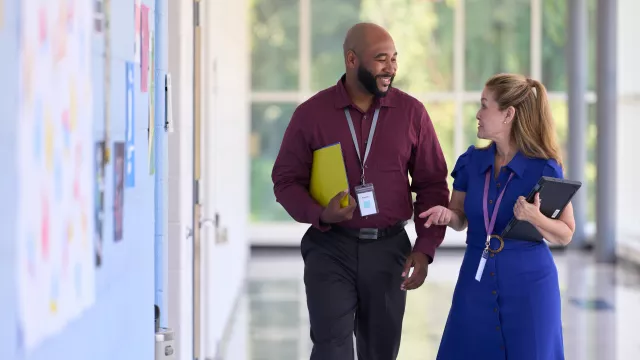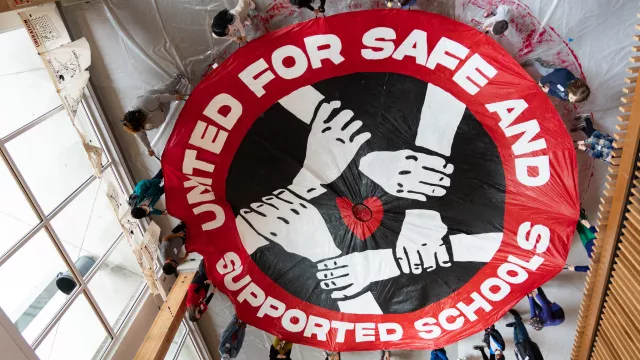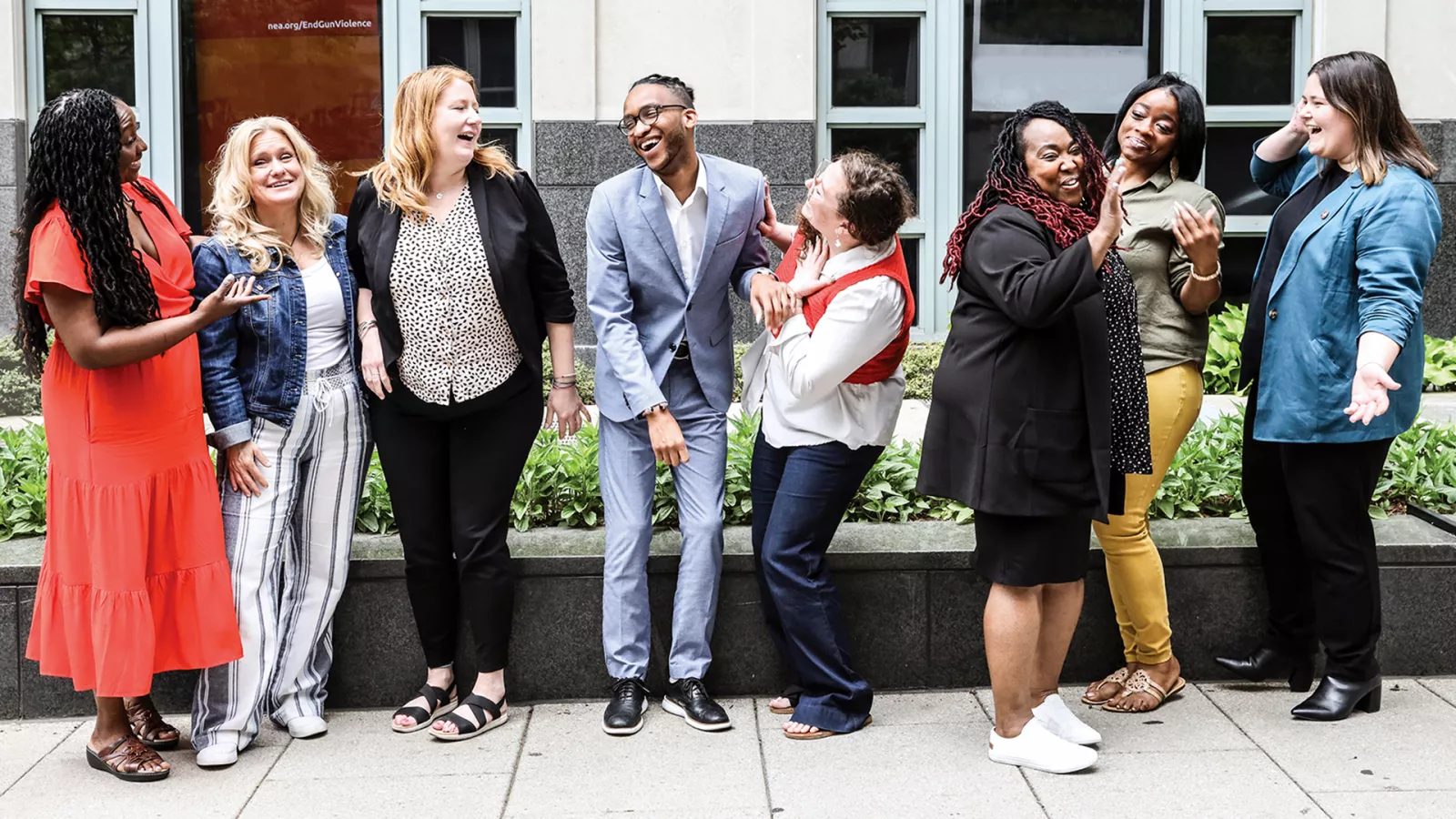How to use this toolkit
- Don’t read the scripts in this guide verbatim. The most compelling way to get your colleagues to join is through a one-on-one conversation where you are engaging and listening authentically.
- Ask questions about the person and don’t be afraid to share a bit about yourself. Building a personal connection is the best way to recruit new members.
- Emphasize personal experience and local wins that your local association has delivered for members.
Why Transformational Conversations
Thank you for taking the time to help build a stronger union.
When we speak up as part of our local union, we can win improvements to our daily lives, from higher salaries to protected planning time and guaranteed bathroom breaks. Each new member adds another voice to the millions of educators across the country working together to accomplish things one educator, one bus driver, one janitor, or even one district can’t.
One-on-one conversations are the most effective way to share the importance of membership to fellow educators. When members speak about how their local makes a difference in their own work, community, and personal lives, they are an influential force in building power in the union.
By following the tips shared in this guide, you or your members will be able to communicate the transformational benefits of joining together as a union.
Preparing for Your Organizing Conversation
Preparing for Your Organizing Conversation
You do not have to have all the answers to questions from members and potential members, you can prepare for transformational organizing conversations and typical questions.
Affirm, answer, and redirect (AAR) when possible.
- Affirm: Let them know you’re listening, you understand, and their feelings are valid. Don’t get mad at them—validate and educate them.
- Answer: Give a truthful, concise answer to the question. If you don’t know the answer, don’t guess. Tell them you’ll find out and get back to them.
- Redirect: Once you’ve answered the question, bring the conversation back to ask them to join membership.
Facts to have on hand:
- Local leader names/association rep. names by worksite.
- Dues information (per paycheck/month).
- Committee & volunteer opportunities for members.
- Resources available (worksite level, local level, state level, national level).
- Political Action Committee or other electoral/legislative information.
- Competing organization facts.
Conversation Cheat Sheet
Conversation Cheat Sheet
- I’m __________________. I’m an educator at ___________________, can I have a few minutes of your time?
- I’m here today as a member of _______________________, our local association for educators like you.
- How long have you been working here? How’s it going this year?
- What is one thing that you would change about your job?
- Are you familiar with _______________________?
- We have _____________________ members right here in _____________________ and are part of a national network with nearly three million members.
- Our local association is made up of educators like us, who band together to help give all of us a stronger voice that can be used to improve our daily lives and help you change things like______________________________________________________________.
- That starts with advocating for higher salaries and better working conditions for educators right here.
Together, we have worked with school administrators, school boards, and lawmakers from both political parties to: _____________________________________.
For example:
- Improve healthcare benefits.
- Expand student loan forgiveness and repayment programs.
- Get duty-free lunches for educators.
- Improve the daily lives of educators so we are equipped to give students our best.
Ask them to join their union!
- Being an educator is one of the hardest jobs in the world and it’s never been harder than right now. With more members like you, we’ll have a stronger collective voice that improves our daily lives so we can give students our best. Will you join ______________________________ as a member?
- Do you know much about the benefits of being a member?
- In addition to giving us a stronger voice in important decisions that impact our daily lives, ___________________________ members receive comprehensive benefits including:
- Liability insurance to protect educators from false or unfair accusations
- Discounts on school-related items
- Professional learning resources and opportunities
- Are these things you could find helpful?
- Are these things you could find helpful?
Sharing Union Wins
Sharing Your Union Wins
It’s important to highlight the transformational power of union membership. Make sure to prepare several examples of ways educators have won positive changes through their union. If you are having a hard time shaping your stories of success, try using our BRAG formula!
B.R.A.G. Formula for Union Wins
If you don’t yet have a concrete win (or can’t think of one), share the issues your union is working on now and how you plan to succeed. Remember, with more members, your union becomes more powerful and is better equipped to create change!
Effective organizing should result in membership growth, increased engagement, expanding leadership, and real wins in the policies and practices that impact our members, our schools, our students and our communities—grounded in our values of equity, opportunity, and racial justice.
Be a Better Listener
LISTENING WELL IS YOUR BEST TOOL TO RECRUIT NEW MEMBERS.
The majority of your time in an organizing conversation should be spent listening to the other person. Not only does this show them you (and your union) cares about them, it also helps you to understand the issues that they want to get involved in. This will make you more effective at convincing them to join the union and become a leader!
Be a Better Listener:
Things to Avoid:
Talking Points
Transformational Talking Points
Equip organizers with these talking points and resources so they feel deputized and ready to start having transformational conversations with potential members!
Find suggested talking points in our recruitment conversation guides for Collective Bargaining States and Non-Collective Bargaining States. We have also created conversations guides designed to help you talk about issues important to our members. Check out resources on the following topics: Student debt, union 101, health care, and pensions.
Key Recruitment Message
[SEA/LEA] is the union for educators in our area. XX% of educators here in [state/district] are already members [if % is unavailable or really low: “We are part of the largest labor union in country”]. We work together to ensure that educators like you have a stronger voice so that we can actually be heard, get important issues addressed, and improve our daily lives.
[SEA/LEA] is a union, which means that we have a legally protected right to negotiate for the causes we care about as educators. We regularly meet with lawmakers from both political parties to increase support for public education and negotiate with school administrators and school boards to make sure educators’ voices are being heard and respected.
We have worked with school administrators, school boards, and lawmakers from both political parties to: [reference specific SEA/LEA wins if possible]
- Negotiate for increases in salaries, though this is only a start and educators
deserve more. - Win dedicated planning time for teachers.
- Protect educators from mandates for additional work on nights and weekends.
- Get schools to hire more staff to reduce class sizes and avoid understaffing.
- Win student loan forgiveness and generous repayment plans for educators.
- Improve the daily lives of educators so we are equipped to give students
our best.
Being an educator is one of the hardest jobs in the world and it’s never been harder than right now. Banding together is the best way to make a real difference. With more members like you, we’ll have an even stronger voice to improve our daily lives the lives of our students.
Frequently Asked Questions
Sometimes organizers will be asked questions that seem difficult to answer. Use these prompts to help you craft your response.
They ask a question you don't know the answer to:
Don’t answer a question if you don’t know the answer. It’s OK to tell your recruit that you don’t know and will get back to them!
More Resources
You’re ready to get started!

Let's Talk About Series

Year-Round Organizing Framework

More Recruitment Resources
Speak Up For Students and Public Schools

